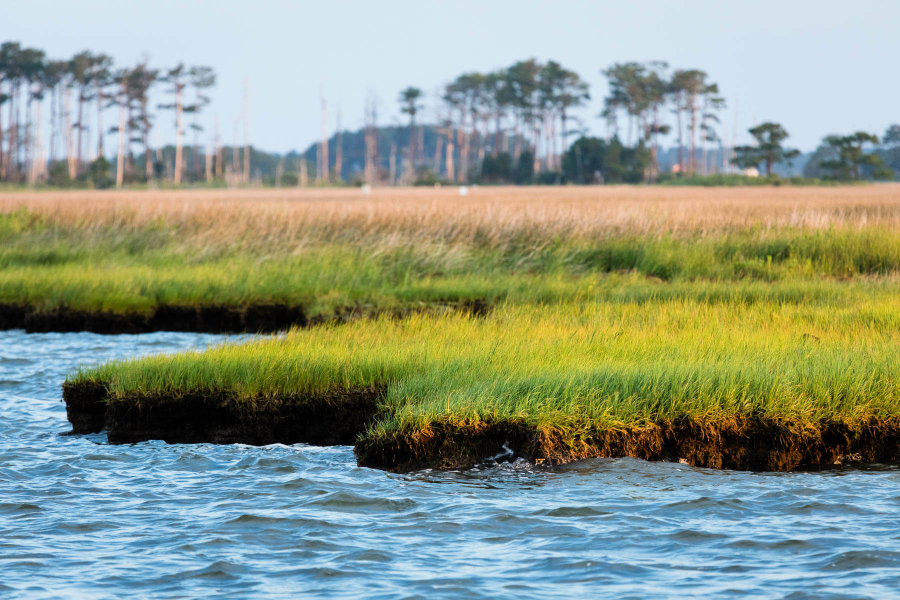How Chesapeake Bay wetlands can contribute to U.S. carbon reduction goals

The Chesapeake Bay is surrounded by thousands of miles of coastal habitats filled with the sound and beauty of birds, waterfowl, crabs and many other species that depend on salt marsh and underwater grass ecosystems. These ecosystems protect our coasts from flooding, filter pollutants, provide nursery grounds and shelter for different species of birds, among many other benefits. But did you know that these habitats are a natural solution that can also help slow climate change impacts?
Increasing concentrations of greenhouse gases, such carbon dioxide, in the atmosphere lead to changes in our climate, such as rising temperatures, intense heat waves and heavier rainfall events. You might be familiar with the key role forests play in absorbing carbon dioxide from the atmosphere and thus mitigating climate change impacts. Similarly, salt marshes, mangroves and underwater grass habitats absorb carbon dioxide from the atmosphere and store it within leaves, stems, branches and mostly within their soil. In healthy habitats, the carbon stored in soils can remain there for hundreds or even thousands of years. The carbon that is absorbed and stored by these coastal habitats is commonly called “blue carbon.” By removing and keeping this carbon out of the atmosphere, coastal habitats can reduce carbon contributions to global climate change.
Unfortunately, these coastal habitats are in danger of disappearing. Studies have suggested that nationwide more than 30% of salt marshes, mangroves and underwater grass meadows have already disappeared in the last decade and about 100 square miles continue to be lost every year. In the Chesapeake Bay watershed, 1,566 acres of wetlands were lost between 1992 and 2010, and even with conservation strategies in place, these ecosystems continue to be threatened.
Activities threatening these habitats include deforestation, urbanization, changes in land use, coastal development, nutrient pollution and sea level rise, which effectively floods wetland areas and kills vegetation. Once these habitats are degraded or damaged, they lose their ability to absorb carbon dioxide from the atmosphere and the carbon stored in their soil is returned to the oceans and the atmosphere, intensifying climate change. Researchers have found that between 0.15 to 1.02 billion tons of carbon dioxide are returned annually into the atmosphere by degraded coastal ecosystems.
There are different strategies we can use to reestablish and protect salt marshes and underwater grass beds in the Chesapeake Bay. Common strategies include federal and local regulations that protect wetlands, the management of wastewater and stormwater to decrease pollutants, control of invasive species and allowing salt marshes to migrate inland by protecting adjacent land.
Yet another strategy that has not yet been utilized is to peruse coastal blue carbon crediting. Through this system, individuals, organizations and businesses would be able to buy and sell “credits” that represent the conservation or restoration of wetland areas. For example, a company promising to go carbon-neutral would continue to generate carbon dioxide, but offset this contribution by purchasing blue carbon credits that come in the form of protected Bay wetlands.
Developing blue carbon projects would be one additional way of safeguarding Chesapeake wetlands, which serve both a local and global purpose in the fight against climate change. The Chesapeake Bay Program’s Climate Resiliency Workgroup is exploring the potential use of this strategy through conversations with finance experts and the review of existing blue carbon crediting protocols for the identification of science and policy needs.
If you would like to learn more about the climate resilience efforts at the Chesapeake Bay Program, visit the Climate Resiliency Workgroup’s webpage.

Comments
How do wetlands help with carbon reduction?
Thank you!
Your comment has been received. Before it can be published, the comment will be reviewed by our team to ensure it adheres with our rules of engagement.
Back to recent stories